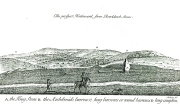Archaeology & History
In days of olde there were heathen sites around the edges of the beautiful Rollright Stones complex that have sadly fallen prey to the intensive agriculture of more modern ‘civilized’ times. It’s become the way of things….. One site of importance in this geomythic pantheon was the ‘Gough’s Barrow’—so named after a drawing was done of the site by Richard Gough, editor of the 1789 edition of Camden’s Britannia. As far as I’m aware, it is the only one ever done of this monument. The Oxford archaeologist George Lambrick (1988) saw “every reason to accept the position and details of the barrow”, upon which stood at least two large stones—one of which gained the description of a ‘druidical pillar.’
The same barrow may have been recorded in one of drawings of the great William Stukeley, who visited the Rollright Stones in 1710 and then again in 1723. On the left-side of the adjacent drawing you can see a denuded mound close to the edge of the picture, similar in shape and form to that drawn by Richard Gough. It is probably the same tumulus or barrow. Trial excavations at the site in 1983 looked for any remains of the old tomb, but nothing significant was uncovered. Lambrick estimated that the site probably measured “about 18m wide and 20m long east-west,” and “was a megalithic barrow and was therefore probably Neolithic in origin.”
References:
- Bennett, Paul & Chanter, James, The Complete Rollright Stones, forthcoming
- Bennett, Paul & Wilson, Tom, The Old Stones of Rollright and District, Cockley Press: Chipping Norton 1999.
- Burl, Aubrey, Great Stone Circles, Yale University Press 1999.
- Lambrick, George, The Rollright Stones, English Heritage 1988.
- Peters, Frances, “An Antiquarian Visit to the Rollright Stones,” in Wiltshire Archaeological & Natural History Magazine, volume 94, 2001.
- Stukeley, Willliam, Abury – A Temple to the British Druids, London 1743.
© Paul Bennett, The Northern Antiquarian
The map could not be loaded. Please contact the site owner.

